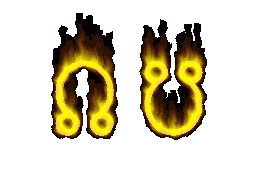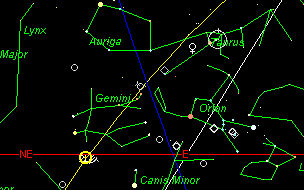 From the cup of immortality drank the disguised demon, Rahu and Ketu1, who were then one. This nectar of the gods was intended only for the gods but had been wrongfully consumed by the demon, conferring upon it immortality. The deception, discovered by the Sun and Moon, ensured eternal enmity between the lights and the demon. Lord Vishnu then severed the demon in half creating the Dragon's head and tail, but their acquisition of eternal life from the potion ensured their continued existence. Thus the Hindu legend accounts for the phenomenon of the eclipses.
From the cup of immortality drank the disguised demon, Rahu and Ketu1, who were then one. This nectar of the gods was intended only for the gods but had been wrongfully consumed by the demon, conferring upon it immortality. The deception, discovered by the Sun and Moon, ensured eternal enmity between the lights and the demon. Lord Vishnu then severed the demon in half creating the Dragon's head and tail, but their acquisition of eternal life from the potion ensured their continued existence. Thus the Hindu legend accounts for the phenomenon of the eclipses.
It is also from this legend and an understanding of the astrological meaning of the eclipses that one can fully grasp the importance of the Nodal influence. The eclipses themselves indicate an interruption of light and energy, and a concentration of gravitational force which has an affect upon the earth. The nature of the eclipse itself suggests life, death and rebirth or regeneration and essentially, eternal life, all of which are represented by the second - eighth house axis and their natural rulers, Taurus - Scorpio, Venus - Mars, but also Pluto under the western system of astrology in respect of the eighth house. It is understandable then how then how one ancient source assigns the exaltation (uchcha) of Rahu and Ketu to Taurus and Scorpio respectively. However, other sources state that Rahu and Ketu are exalted in Gemini-Virgo.
The mystery of this conflict can be solved be delving into the problem from an archaeoastronomical viewpoint. As civilisation dawned, the magnificent constellation of Orion rose heliacally at the northern spring equinox. To the ancient inhabitants of the earth, his symbolism would naturally be associated with eternal life and regeneration, for under his star the whole of nature and earth flourished. To the Egyptians he was the god Osiris, whilst to the Babylonians he was known as the Great Shepherd, Sitaddalu. As the ages progressed and Orion gradually merged with the sun's rays at the Spring Equinox, he came to hold the key of life - the sun - in his right hand. This symbolism was later expressed as the ankh, which all the ancient gods of Egypt held and later came to be the symbol of Venus, the Morning Star. In 4420 BC, the vernal point reached the exact celestial longitude of Betelgeuse in the right shoulder of Orion, although its name is derived from the Arabic meaning "right hand". 2
 Orion is mostly located within the sidereal region of Taurus but also straddles the cusp of Taurus - Gemini, with the brightest star in Orion, Betelgeuse, being located in Gemini. Thus it is that the symbolism of eternity transferred to Taurus - Gemini and death to Scorpio, for Scorpio was prominent heliacally at the northern autumn equinox. It is also possible from this scenario to understand how the second, seventh and eighth house rulers came to be Marakas, indicators of death under the Vedic system. There is obviously a deep-rooted Vedic tradition dating back to this period and supporting claims that the Vedic legends date to around 5,000 BC.
Orion is mostly located within the sidereal region of Taurus but also straddles the cusp of Taurus - Gemini, with the brightest star in Orion, Betelgeuse, being located in Gemini. Thus it is that the symbolism of eternity transferred to Taurus - Gemini and death to Scorpio, for Scorpio was prominent heliacally at the northern autumn equinox. It is also possible from this scenario to understand how the second, seventh and eighth house rulers came to be Marakas, indicators of death under the Vedic system. There is obviously a deep-rooted Vedic tradition dating back to this period and supporting claims that the Vedic legends date to around 5,000 BC.
Thus it could be safely said that Rahu is exalted in Taurus and Gemini, and operates well in the other two signs ruled by Venus and Mercury, viz Libra and Virgo. It is from this understanding that Rahu's demonic influence is materialistic and hedonistic whilst Ketu's is a negative etherialism which can be related to 12th house and Piscean influences.
1 Moons North and South Nodes
2 Moroney, A., "Pathway to Atlantis", Sydney, 1998, p 34
© Copyright, Alison Moroney, 2000
First published in "Astrological Monthly Review"